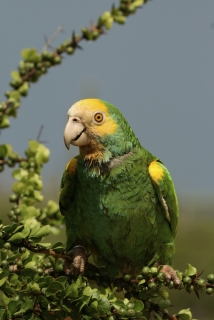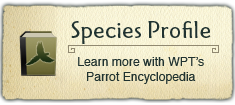Project Regions:
Yellow-shouldered Amazon |
|
|
Collaborators/Funders
ECHO (Bonaire), RARE, University of Missouri-St. Louis, Disney Wildlife Conservation Fund (DWCF), STINAPA, Dutch Caribbean Nature Alliance, Birdland UK, Drayton Manor Zoo, Exmoor Zoo, Harewood Bird Garden
Trapping and habitat loss are endangering Yellow-shouldered Amazons
The Yellow-shouldered Amazon lives in a very restricted range with islands affected by forest loss due to tourism and overgrazing by domestic animals. In some areas is persecuted for allegedly visiting crops and is exploited for trade. It also suffers from predation by introduced mammals. The mainland population is apparently low. It has been reported on Curaçao and is now extinct on Aruba.
How WPT makes an impact: Beginning in 2002 WPT began supporting projects to protect the Yellow-shouldered Amazon on Bonaire and in Venezuela. In 2002 a ringing and amnesty initiative with local nature and environment conservancy organisations began on Bonaire, with WPT providing 600 bands for pet parrots. The WPT is currently helping Echo, an NGO that surveys the population and studies habitat use, and rescues, rehabilitates and releases parrots caught in the trade. In addition, the team protects and restores key habitat with native plantings, controls overgrazing domestic animals, protects nests, carries out breeding-for-release, encourages sustainable tourism and works to mitigate conflict with farmers.
Population: 2590 - 8470
Vital statistics: Size: 33 cm (12.8 in) Weight: 270 g (9.4 oz)
Range: Restricted to small coastal area in Venezuela and the islands of Blanquilla, Margarita and Bonaire. Introduced to Curaçao, Netherlands Antilles.
Natural history: Occurs in areas with cacti and thorny bush and trees; also cultivated areas and mangroves. Found up to 450m (1476 ft) on Margarita, possibly higher on the mainland. Takes fruits of trees and bushes, seeds, nectar-rich blossoms, cactus tops and fruit. Breeding is March-September; sometimes October on Bonaire. Nest is in a tree, cliff or cactus cavity.
Project Updates
- PsittaScene Vol. 25.1, Feb. 2013
- PsittaScene Vol. 23.3, Aug. 2011
- PsittaScene Vol. 22.1, Feb. 2010
- PsittaScene Vol. 21.3, Aug. 2009
- PsittaScene Vol. 21.3, Aug. 2009
- PsittaScene Vol. 19.2, May 2007
- PsittaScene Vol. 18.3, Aug. 2006
- PsittaScene Vol. 16.1, Feb. 2004
- PsittaScene Vol. 15.1, Feb. 2003
WPT-sponsored research:
Other publications:
Google scholar - Amazona barbadensis


































